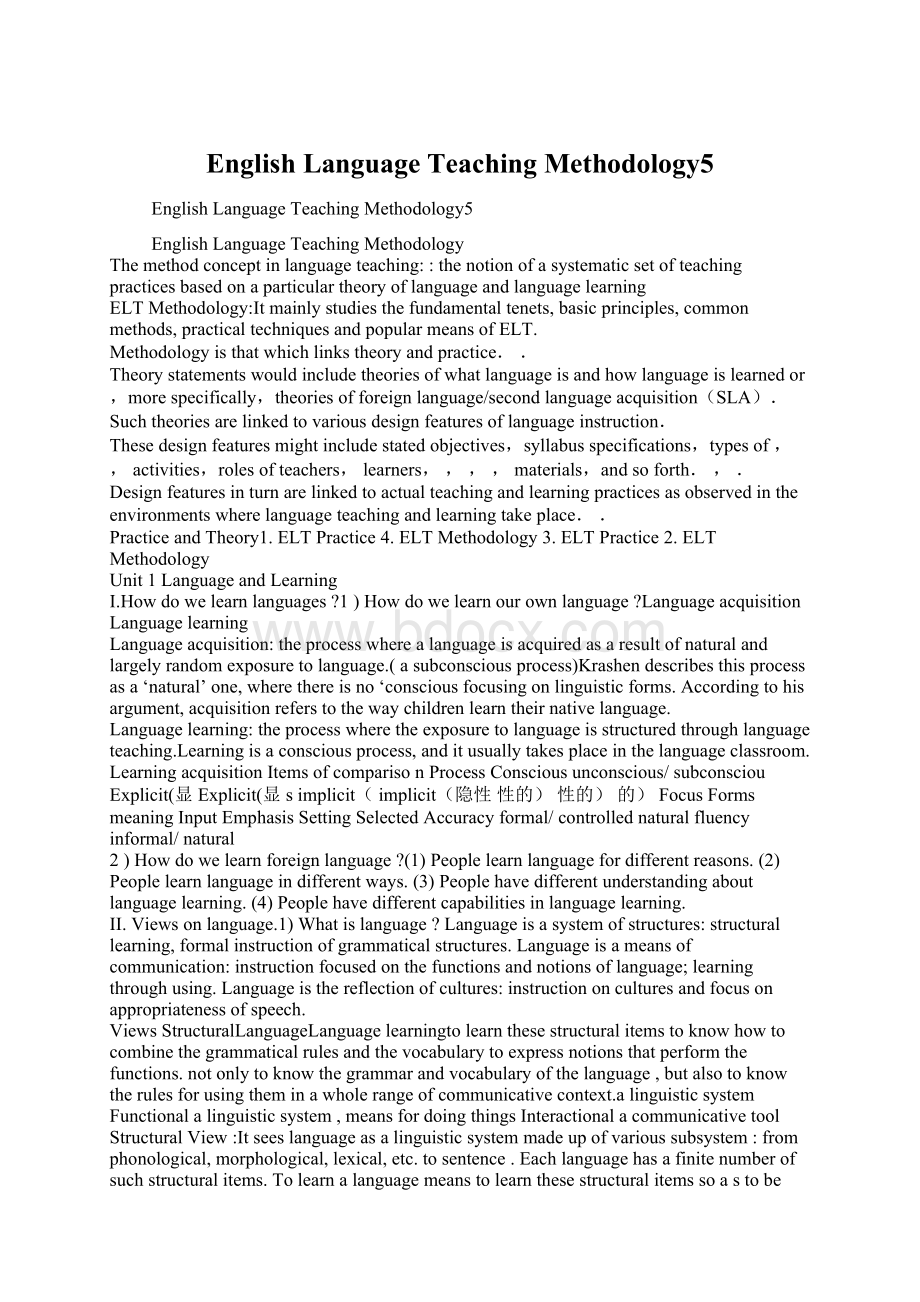English Language Teaching Methodology5.docx
《English Language Teaching Methodology5.docx》由会员分享,可在线阅读,更多相关《English Language Teaching Methodology5.docx(4页珍藏版)》请在冰豆网上搜索。

EnglishLanguageTeachingMethodology5
EnglishLanguageTeachingMethodology5
EnglishLanguageTeachingMethodology
Themethodconceptinlanguageteaching:
:
thenotionofasystematicsetofteachingpracticesbasedonaparticulartheoryoflanguageandlanguagelearning
ELTMethodology:
Itmainlystudiesthefundamentaltenets,basicprinciples,commonmethods,practicaltechniquesandpopularmeansofELT.
Methodologyisthatwhichlinkstheoryandpractice..
Theorystatementswouldincludetheoriesofwhatlanguageisandhowlanguageislearnedor,morespecifically,theoriesofforeignlanguage/secondlanguageacquisition(SLA).Suchtheoriesarelinkedtovariousdesignfeaturesoflanguageinstruction.
Thesedesignfeaturesmightincludestatedobjectives,syllabusspecifications,typesof,,activities,rolesofteachers,learners,,,,materials,andsoforth.,.Designfeaturesinturnarelinkedtoactualteachingandlearningpracticesasobservedintheenvironmentswherelanguageteachingandlearningtakeplace..
PracticeandTheory1.ELTPractice4.ELTMethodology3.ELTPractice2.ELTMethodology
Unit1LanguageandLearning
I.Howdowelearnlanguages?
1)Howdowelearnourownlanguage?
LanguageacquisitionLanguagelearning
Languageacquisition:
theprocesswherealanguageisacquiredasaresultofnaturalandlargelyrandomexposuretolanguage.(asubconsciousprocess)Krashendescribesthisprocessasa‘natural’one,wherethereisno‘consciousfocusingonlinguisticforms.Accordingtohisargument,acquisitionreferstothewaychildrenlearntheirnativelanguage.
Languagelearning:
theprocesswheretheexposuretolanguageisstructuredthroughlanguageteaching.Learningisaconsciousprocess,anditusuallytakesplaceinthelanguageclassroom.
LearningacquisitionItemsofcomparisonProcessConsciousunconscious/subconsciouExplicit(显Explicit(显simplicit(implicit(隐性性的)性的)的)FocusFormsmeaningInputEmphasisSettingSelectedAccuracyformal/controllednaturalfluencyinformal/natural
2)Howdowelearnforeignlanguage?
(1)Peoplelearnlanguagefordifferentreasons.
(2)Peoplelearnlanguageindifferentways.(3)Peoplehavedifferentunderstandingaboutlanguagelearning.(4)Peoplehavedifferentcapabilitiesinlanguagelearning.
II.Viewsonlanguage.1)Whatislanguage?
Languageisasystemofstructures:
structurallearning,formalinstructionofgrammaticalstructures.Languageisameansofcommunication:
instructionfocusedonthefunctionsandnotionsoflanguage;learningthroughusing.Languageisthereflectionofcultures:
instructiononculturesandfocusonappropriatenessofspeech.
ViewsStructuralLanguageLanguagelearningtolearnthesestructuralitemstoknowhowtocombinethegrammaticalrulesandthevocabularytoexpressnotionsthatperformthefunctions.notonlytoknowthegrammarandvocabularyofthelanguage,butalsotoknowtherulesforusingtheminawholerangeofcommunicativecontext.alinguisticsystemFunctionalalinguisticsystem,meansfordoingthingsInteractionalacommunicativetool
StructuralView:
Itseeslanguageasalinguisticsystemmadeupofvarioussubsystem:
fromphonological,morphological,lexical,etc.tosentence.Eachlanguagehasafinitenumberofsuchstructuralitems.Tolearnalanguagemeanstolearnthesestructuralitemssoastobeabletounderstandandproducelanguage.
FunctionalView:
Itseeslanguageasalinguisticsystembutalsoasameansfordoingthings.Mostofourday-to-daylanguageuseinvolvesfunctionalactivities:
offering,suggesting,advising,apologizing,etc.Therefore,learnerslearnalanguageinordertodothingswithit.Toperformfunctions,learnersneedtoknowhowtocombinethegrammaticalrulesandthevocabularytoexpressnotionsthatperformthefunctions.
InteractionalView:
Itconsiderlanguageasacommunicativetool,whosemainuseistobuildupandmaintainsocialrelationsbetweenpeople.Therefore,learnersnotonlyneedtoknowthegrammarandvocabularyofthelanguage,butalsoneedtoknowtherulesforusingtheminawholerangeofcommunicativecontext.
III.Viewsonlanguagelearning1)Whatarethepsycholinguisticandcognitiveprocessinvolvedinlanguagelearning?
2)Whataretheconditionsthatneedtobemetinorderfortheselearningprocesstobeactivated?
Process-orientedtheoriesareconcernedwithhowthemindprocessesnewinformation,suchashabitformation,induction,makinginference,hypothesistestingandgeneralization.
Condition-orientedtheoriesemphasizethenatureofthehumanandphysicalcontextinwhichlanguagelearningtakesplace,suchasthenumberofstudents,whatkindofinputlearnersreceive,andthelearningatmosphere.
Behaviouristtheory(行为主义学习理论)行为主义学习理论)行为主义学习理论ProposedbybehaviouralpsychologistSkinner,whoappliedthetheoryofconditioningtothewayhumansacquirelanguage.
---learningashabitformationLanguageisalsoaformofbehaviour.Itcanbelearnedthesamewayasananimalistrainedtorespondtostimuli.
Thekeypointofthetheoryofconditioning“Youcantrainaanimaltodoanything(withinreason)Ifyoufollowacertainprocedurewhichhasthreemajorstages,stimulus,response,andreinforcement”.
Oneinfluentialresultistheaudio-lingualmethod(听说whichinvolvesthe“listen(听说,andrepeat”drillingactivities.Theideaofthismethodisthatlanguageislearnedbyconstantrepetionandthereinforcementoftheteacher.Mistakesareimmediatelycorrected,andcorrectutterancesareimmediatelypraised
Cognitivetheory(认知主义学习理论)认知主义学习理论)认知主义学习理论Thetermcognitivismisoftenusedtodescribemethodinwhichstudentsareaskedtothinkratherthansimplyrepeat.
Ifalllanguageisalearnedbehaviour,howcanachildproduceasentencethathasneverbeensaidbyothersbefore?
AccordingtoChomsky’stheory,languageisnotaformofbehaviour,itisanintricaterule-basedsystem.
Oneinfluentialideaofthistheoryisthatstudentsshouldbeallowedtocreatetheirownsentencesbasedontheirunderstandingofcertainrules.
Accordingtothecognitivetheory,learningisaprocessinwhichthelearneractivelytriestomakesenseofdata.Thebasictechniqueassociatedwithacognitivetheoryoflanguagelearningistheproblem-solvingtask.
Constructivisttheory(建构主义学习理论)(建构主义学习理论)LearningisacomplexcognitiveprocessinwhichthelearnerconstructsmeaningbasedonhisorherownexperiencesandWhathe/shealreadyknows.
ReceivinginformationProcessinginformationConstructingnewmeaningsInput(listening,reading)Decoding(解码)解码)解码(Listening/reading)comprehensionoutputRelatingwhatlearnersalreadyknowwiththereceivedinformation
ImplicationsforclassroomteachingTeachingshouldbebuiltbasedonwhatlearnersalreadyknowandengagelearnersinlearningactivities.Teachersneedtodesignactivitiestoarouselearners’interestsandcuriosityforlearning
Toprovidethebackgroundinformationtoactivatelearners’schema(激活图式);激活图式)激活图式Tomotivatestudentsbymakingthetopicrelevantandinterestingtothem.
Socio-constructivisttheorySocioculturaltheory(社会文化理论)社会文化理论)社会文化理论维果茨基)RepresentedbyVygotsky(维果茨基)Itemphasizesinteractionandengagementwiththetargetlanguageinasocialcontextbasedontheconceptof‘ZoneofProximalDevelopment’(ZPD,最近发展区)andscaffolding(support).
Inotherwords,learningisbestachievedthroughthedynamicinteractionbetweentheteacherandthelearnerandbetweenlearners.
ZoneofProximalDevelopment(ZPD最近发展区)Itisthedistancebetweentheactualdevelopmentallevelasdeterminedbyindependentproblemsolvingandthelevelofpotentialdevelopmentasdeterminedthroughproblemsolvingunderadultguidanceorincollaborationwithmorecapablepeers(Vygotsky(1978:
86))
“最近发展区”理论:
前苏联心理教育学家最近发展区”理论:
最近发展区维果茨基的长期研究揭示的长期研究揭示:
维果茨基的长期研究揭示:
教育对学生的发展能起主导作用和促进作用,能起主导作用和促进作用,但要确定学生发展的两种水平,一种是已经达到的水平,的两种水平,一种是已经达到的水平,表现为学生能够独立解决的智力任务,学生能够独立解决的智力任务,另一种是儿童可能达到的发展水平,可能达到的发展水平,表现为儿童还不能独立地解决任务,但在成人的帮助下,地解决任务,但在成人的帮助下,在集体活动能够解决这些任务。
中,能够解决这些任务。
这两种水平之间的距离就是“最近发展区”把握好最近发展区,离就是“最近发展区”。
把握好最近发展区,能加速学生的发展。
能加速学生的发展。
最近发展区(ZPD)AB独立解决问题的水平theactualdevelopmentallevelasdeterminedbyindependentproblemsolving在教师指导下解决问题的水平thelevelofpotentialdevelopmentasdeterminedthroughproblemsolvingunderadultguidance
Implicationsforclassroomteaching“最近发展区”的概念对于教学的意义是:
课堂教学的每个环节,必须适合学生的“最近发展区”,既不消极适应或滞后于学生现有的智力发展水平,也不过度超前于学生现有的水平。
应当从有利于促进学生智力发展的角度去考虑,让学生“跳一跳摘到果子”。
Learnability(可学性):
可学性)可学性thecontentsandtasksplannedforthelessonshouldbewithinthelearningcapabilityofthestudents.Ofcourse,thingsshouldnotbetooeasyeither.Doingthingsthatarebeyondorbelowthestudents’copingabilitywilldiminishtheirmotivation.
Krashen’ssecondlanguageacquisitiontheory(第二语第二语言习得理论)言习得理论)Acquisitionisdependentonthelearners’obtainingcomprehensiveinput.Forlearningtotakeplace,theremustbeexposuretothetargetlanguage,followingtheprincipleofi+1.
Scaffolding(支架理论)TheconceptofscaffoldingoriginateswiththeworkofWoodetal.(1976)anditservesasametaphorforthenovice-masterinteractioninaproblem-solvingtask.
AccordingtoWoodetal.,“scaffoldinginvolvestheexperttakingcontrolofthoseportionsofataskthatarebeyondthelearnerscurrentlevelofcompetence,thusallowingtheleanertofocusontheelementswithinhisorherrangeofability”
IV.Whatmakesagoodlanguageteacher?
thewould-beteachersAreyoureadyforyourfutureteaching?
Whatpreparationshaveyoumadeforyourcareer?
Whatqualificationshaveyouobtainednow?
Whatwillyoudoifyouhaven'tgottherequiredqualifications?
qualifications?
Whatqualitiesdoyouth